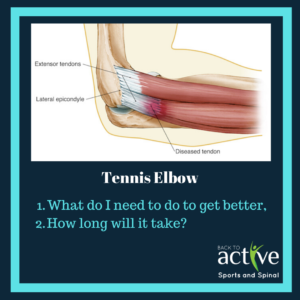Tennis elbow/lateral epicondylitis

Have you experienced pain while playing racquet sports? Or do constantly participate, or have recently participated, in manual heavy jobs? If so, and if you are currently experiencing pain on the lateral side of your elbow, this article will help explain what tennis elbow is and what you can do to get better!
What is it?
Tennis elbow is an overuse injury to the common extensor tendons originating in your lateral elbow. It is part of a category of injuries called tendinosis. These injuries are most common for patients complaining of elbow pain and is caused by repetitive wrist extension (i.e the backhand motion in tennis or squash).
What do I need to do to get better, and how long will it take?
All tendinopathies are essentially a build-up of dysfunctional proteins within our tendon leading to pain and focal thickening. The tricky thing is that all Tennis elbow cases will not get better with relative rest contrary to popular belief. Instead what is required is a gradual, graded program to ease the patient back into meaningful and functional tasks. When the patient participates in these programs, they are promoting better linear growth of the muscle and reabsorption of dysfunctional protein (collagen). Many programs will start off with isometrics exercises (which means contracting the effected muscles without eliciting movement) and slow eccentric exercises (motion of an active muscle while it is lengthening under load). Respectively, this is pressing your forearm against the wall and pressing your wrist back into the wall; and cocking your wrist back while holding a heavy water bottle, then applying gravity and letting your wrist slowly drop forward. It’s also important to address adjacent muscles around the forearm and arm; and even postural issues which may predispose the patient to tennis elbow.
When it comes to prognosis, everyone will take a variable amount of time and respond differently to treatment (this is affected by the lifestyle of the patient, whether they work a wrist manual job, or whether their job demands them to apply wrist work aggressively, which is not conducive to recovery) . In more severe cases tennis elbow may take even up to multiple years. However with a program implemented, the patient may take anywhere between 6 weeks to one year.
Signs and Symptoms
- Sharp pain with wrist extension, gripping activities
- Decreased grip strength
- Potential neurological involvement (radial tunnel syndrome)
- Potential referrer pain (up shaft of humerus)
- Localised tenderness
Risk Factors
- Racquet sports – particularly, poor swing technique, heavy racquet, incorrect grip size and high string tension
- Manually heavy labour (gripping and lifting tasks)
- Most common in 35 – 50 age group
- Men and women equally affected.
- Usually in dominant arm.
Solution
The common nonoperative treatment includes: activity modification, ice, taping, deep heat, counter bracing, dry needling and ultrasound. However, with injuries such as tennis elbows, it is important to understand that tendinosis injuries generally do not recover with relative rest. Instead it is important to follow a prescribed protocol for these exercises. These exercises will gradually reintroduce tensile forces at an appropriate manner to the tendon. When this occurs, it will stimulate protein turnover rectifying the underlying dysfunction within the tendon.
All tendinosis are painfully frustrating to heal due to its slow rehab. However there is up to 95% success rate with nonoperative treatment.
Upon more severe cases that have not responded to conservative management, physiotherapy may also use extracorporeal shockwave therapy as a more aggressive form of therapy. Finally, if all physiotherapy modalities are unfruitful, surgery may be indicated if patients are eligible.
Here’s an example of a set of simple guidelines for someone with acute tennis elbow:
Remember that these programs are performed to rectify the dysfunctional collagen in the patient’s arm. Therefore, pain needs to be 3/10 or less; and settle within 24 hours otherwise you will be promoting dysfunctional protein growth rather than correct protein reabsorption and growth.
Stage 1
- Isometric wrist extension: Holding for 20 seconds, 3 x 10
- Eccentric wrist extension with a 2kg dumbbell (elbow bent at 90 degrees) 5 x 10
- Eccentric wrist extension with theraband (elbow bent at 90 degrees) 3 x 10
Stage 2
- Eccentric wrist extension with a 2kg dumbbell (elbow straight) 5 x 10
- Wrist rollups (2kg roll ups) 3 x 10
- Hammer supination exercise 3 x 10
- Light hammer curls (2kg) 3 x 10
- Reverse grip bicep curls (2kg) 5 x 10

Stage 3
- Career or sport specific activities
- Integrating forearm rehab with postural issues.
Tennis elbows are painful, most of us have experienced it without actually attending to the underlying dysfunction. Therefore, it is encouraged that professional advice is sought so that the injury can be appropriately managed and activities modified.
Article by Joshua Shum (Physiotherapist)
